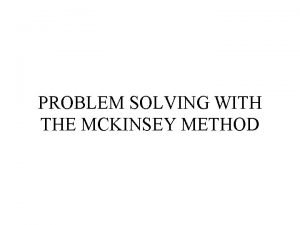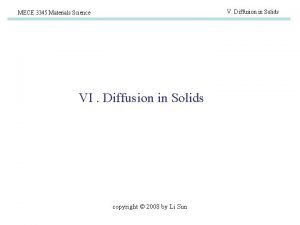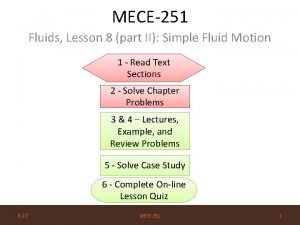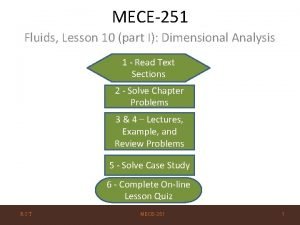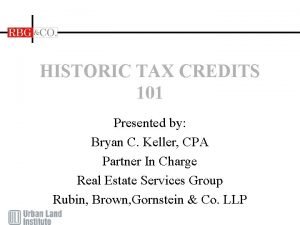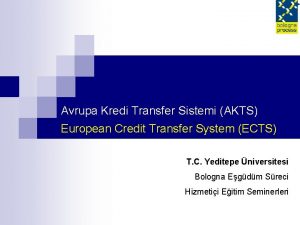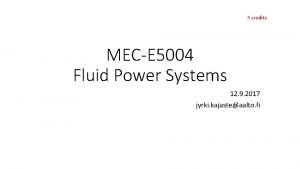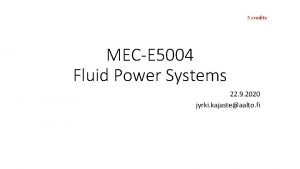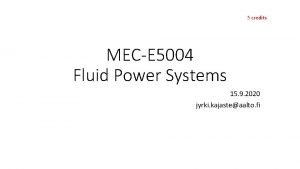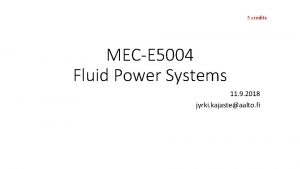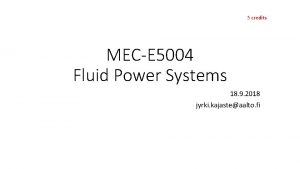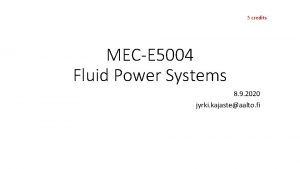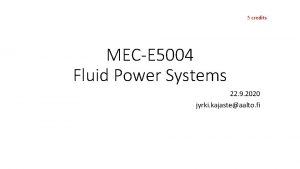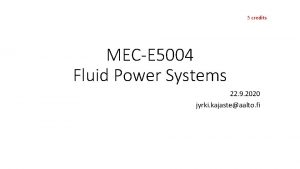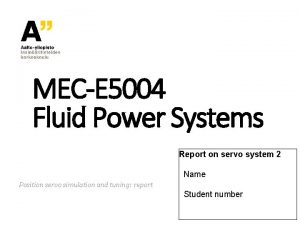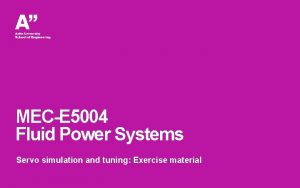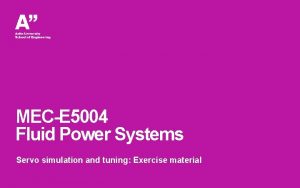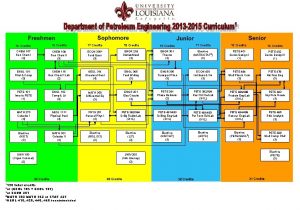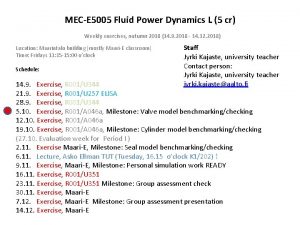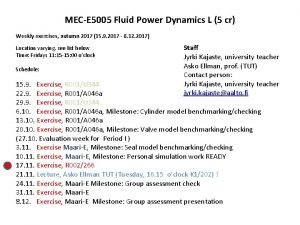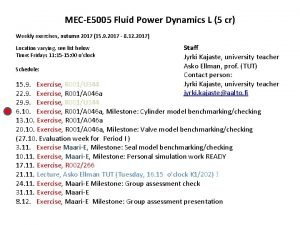5 credits MECE 5004 Fluid Power Systems 15



















- Slides: 19

5 credits MEC-E 5004 Fluid Power Systems 15. 9. 2020 jyrki. kajaste@aalto. fi

Structure of studies and Grade components IN BRIEF • Presentations and lectures • Simulation assignments 1. Tuning a hydraulic servo 2. Building hydraulic simulation models 1. 2. Load Sensing (LS) system Direct Drive Hydraulic (DDH) system • Each student: Individual Reports • Group assignment • 3 calculation assignments • group’s discussions with the teacher Common and organized Studies (almost) every Tuesday 16. 15 -18. 00 Simulation (4) and servo simulation (2) exercises on 4 Wednesdays 16. 00 -18. 00 (see detailed schedule) Student groups arrange their own meetings and teamwork conventions 2

Introduction to Energy Efficient Fluid Power The main theme of Fluid Power Systems course year 2020 is Energy Efficient Fluid Power The • Presentations • Lectures given by our researchers support this main theme Other relevant topics in modern and future Fluid Power also introduced. 3

Schedule Preliminary schedule (under construction) Tuesday sessions could be used also for simulations 3 Calculation assignments 2 Simulation assignments 2 Servo simulations Group meeting 4

Group assignments (group works) 18 students ? • Wish is to … have groups with 3 members Output • 3 calculation assignments • 1 group’s meeting with the teacher plan • Build up your team until Tuesday 15. 9. 2020 • Use My. Courses page Assignments 5

Energy Balance of Electro-Hydraulic Powertrain in Micro Excavator The actuators (cylinders) used in the tests. 1. Boom 2. Arm 3. Bucket • Experimental results ad some simulations as well • Electrified small sized excavator, a 1. 1 -tonne JCB Micro • Equipped with conventional hydraulics. • The overall energy balance of the electro-hydraulic powertrain. 2 • The power losses in individual components. 3 1 • Measured energy balance of the electric motor powered system is compared with the simulation data obtained from a preliminary simulation model of the system. • The results will be in future research utilized to discover and compare new alternatives for powertrain architectures. Based on: Energy Balance of Electro-Hydraulic Powertrain in a Micro Excavator Otto Gottberg, Jyrki Kajaste, Tatiana Minav*, Heikki Kauranne, Olof Calonius, Matti Pietola 6

2 1. Boom 2. Arm 3. Bucket The system • Batteries (Lead-acid, 72 V) as energy source • Inverter based motor controller • AC motor as prime mover (originally diesel powered) • Rotational speed can be adjusted/controlled • Hydraulic system • Two gear pumps • Constant pump Load Sensing (LS) system 1 3 Number Description Details 1 Battery pack 72 V Lead-acid 2 Motor controller Sevcon Gen 4 3 Electric motor 4 Dual pump 5 6 10 k. W Parker PGP 511 Pressure relief valve (PRV) Pressure adjustment valve 7 PRV LS-circuit 8 Proportional valve 9 Current sensor LEM DK 200 10 Torque and tachometer Kistler 4502 11 Flow sensor 12 Pressure sensor Hydac HDA 13 Position sensor Siko SGH 10 Danfoss PVG-32 Kracht VC 0, 4 7

2. Arm 3. Bucket 5 Power measurements 6 Current clamps 1. Battery output power 1. U and I 2. Current clamps for I 2. Power electronics output NOT measured 3. Electric motor output power – pump input power 1. Shaft torque (T) and angular speed ( ) Wire-actuated encoder for 4. Pumps’ output power displacement 1. p and qv 5. Cylinder input power Gear type 1. Inlet pressures (A and B chamber) flow meter 2. Cylinder position 1. Filter signal and differentiate for speed 2. Speed input flow rate (estimate) 6. Proportional valves’ power losses 1. p and qv (flow rate estimate from cylinder speed) 7. LS system’s Pressure Adjustment Valve’s power loss 1 1. Estimate for flow rate (pump qv – actuator qv: s) 2. Pump pressure 2 1. Boom 5 https: //www. siko-global. com/en-de/products/linearline-wire-actuated-encoders/position-sensors-for-hydraulic-cylinders/sgh 10 1 3 6 Number 5 http: //kracht. eu/en/product-portfolio/flow-measurement/zahnrad-durchflussmesser 1/ 6 7 4 2 3 Description Details 1 Battery pack 72 V Lead-acid 2 Motor controller Sevcon Gen 4 3 Electric motor 4 Dual pump 5 6 10 k. W Parker PGP 511 Pressure relief valve (PRV) Pressure adjustment valve 7 PRV LS-circuit 8 Proportional valve 9 Current sensor LEM DK 200 10 Torque and tachometer Kistler 4502 11 Flow sensor 12 Pressure sensor Hydac HDA 13 Position sensor Siko SGH 10 Danfoss PVG-32 Kracht VC 0, 4 8

Constant pump LS system Maximum pressure of other actuators Shuttle valve senses the highest actuator pressure and sends the information to PAV, which opens to keep the pump pressure about 20 bars higher than the highest (active) actuator pressure. (Passive actuators = a) closed valve or b) negative load, lowering of load) Only when the spool is moved from its center position and furthermore only from the port directing the flow to the actuator, which is to be moved. qv actuators qv PAV 20 bars Normally qv pump= qv actuators + qv PAV qv pump 9

Theoretical power consumption – 2 cases • Constant pump + proportional control valve + PRV • Constant pump + LS: proportional control valve + PAV • Symmetric cylinder for simplicity • The load lifted in these examples is ”lower than maximum” to demonstrate the energy saving potential of the LS system (constant pump LS) 10

Pump Pipe 1 SYSTEM WITH CONSTANT PUMP + PRV x G SYMMETRIC CYLINDER 3 p. B p. A PCV Control Edge PA PCV 2 4 1 Small opening because high pressure drop p p. A LIFTING POWER Fv M High pressure loss for correct piston velocity Pipe 2 p. B WASTED IN PRV Seal Friction Pipe 3 PCV Control Edge BT High power losses in PCV (PA and BT) because pressure has to be dropped from p. P to p. T in the system. Used power Wasted power in valves Pump’s operating point Maximum power, corner power Pipe 4 + FILTER B chamber qv A chamber qv qv Pump 11

SYSTEM WITH CONSTANT PUMP + LS SYMMETRIC CYLINDER PAV p Pump p. LS 20 bar Pipe 1 PCV Control Edge PA LS pressure Large opening because smaller (LS) pressure drop p. A Pipe 2 LIFTING POWER Fv p. B Other power losses are the same as in PRV system, but PCV losses (PA and BT) are smaller Used power Wasted power in valves Pump’s operating point Maximum power, corner power POWER SAVED WASTED IN PAV Seal Friction Pipe 3 PCV Control Edge BT Pipe 4 + FILTER B chamber qv A chamber qv qv Pump 12

Power consumption - pressure and flow rate Fixed-displacement hydraulic pump with PRV Pump Fixed-displacement hydraulic pump with LS system Maximum pressure= pressure relief valve setting p p= 20 bar (LS) WASTED p Pump Used power Wasted power Pump’s operating point Maximum power, corner power USED WASTED qv Load Pump USED POWER includes power needed by the load but also losses in control valves, pipes etc. https: //www. hydraulicspneumatics. com/200/Tech. Zone/Hydraulic. Pumps. M/Article/False/6401/Tech. Zone-Hydraulic. Pumps. M 13

Test cycle Attention! The test cycle is basically ”zero net energy cycle”. The start and end points are the same and the load mass does not change. For an ideal system the energy consumption would be zero. 1. Boom 2. Arm 3. Bucket 2 3 1 Levelling cycle according to standard JCMAS H 020: 2007 when only boom and arm movements are taken into account Cylinder displacements Test procedure and duty cycle defined in the standard H 020: 2007 of the Japan Construction Mechanization Association (JCMAS) [4], originally meant for testing the fuel consumption of hydraulic excavators, was applied. The measurements are conducted without external loading as defined in the standard. Position feedback controllers were used to control the proportional valves via CAN bus. The CAN communication with the valves was 14 implemented with Simulink.

Measurements – energy consumption Battery output Electronics + e-motor losses E-motor output Pump losses Pump output Actuator system use + losses Measured and simulated energy consumption of sub-systems for levelling cycle Measured relative energy use in different subsystems of the power transmission 15

Energy consumption – saving potential? Wouldn’t it be good to get rid of (throttling) valves? Wouldn’t it be good to diminsh pump flow rate here? Friction Hoses PAV Proportional control valves Simulated relative energy use in the actuator system for levelling cycle Measured and simulated flow rates of pumps and cylinders 16 for levelling cycle

Electric LS system? Reduce emotor speed here Flow rates of pumps and cylinders The losses in Pressure Adjustment Valve (PAV) could be remarkably reduced if the pumps’ flow rate would be equivalent to the actual flow rate need of the actuators. The flow through PAV would diminish. In the test system the electric motor (+ controller) is fast enough to adjust the rotational in about 1 second. How to estimate the appropriate rotational speed? 1. We know the openings of Proportional Control Valves (PCV) -> electric signals, CAN bus 2. We measure and know the pressure differences over the PCV: s 3. We can calculate the total flow rate in actuators 4. We can estimate the pump speed Principle simulated (OK!), but not tested! Approach similar to (normal) LS system with variable pump. Variables known 17

Power consumption – electric LS Fixed-displacement hydraulic pump with LS system …. with electric LS system Maximum pressure= pressure relief valve setting p= 20 bar (LS) p Pump USED Load WASTED qv Used power Wasted power Pump’s operating point Maximum power, corner power USED WASTED Pump Load Pump qv Some extra flow USED POWER includes power needed by the load but also losses in control valves, pipes etc. https: //www. hydraulicspneumatics. com/200/Tech. Zone/Hydraulic. Pumps. M/Article/False/6401/Tech. Zone-Hydraulic. Pumps. M 18

Conclusions • Excavator’s energy consumption in leveling cycle was measured (and simulated) • Zero energy work cycle theoretically the energy used for lifting of a load mass or just the boom could be recovered during lowering (potential energy recovery) • No energy recovery sub-system kinetic and potential energy into heat in thottles • All the energy from battery into heat in • • Electric system (controller + e-motor) Pump Valves (PAV + Proportional Control Valves (PCV)) Hoses/pipes/orifices and cylinder friction 19% 13% 58% [<29% + >29%] 10% • System with Pressure Adjustment Valve is better (energy efficiency) than constant pump + PRV • PAV losses could be dimished by estimating the flow rate and applying e-motor speed control towards normal LS control with variable pump 19 • Getting rid of PCV losses is hard with this system architecture (always at least 20
 Mckinsey method
Mckinsey method V-diffusion
V-diffusion Mece
Mece Mece
Mece Fluid sf
Fluid sf Fluid statics deals with fluid at rest
Fluid statics deals with fluid at rest Fluid statics deals with fluid at rest
Fluid statics deals with fluid at rest Total body water
Total body water Bioimpedância
Bioimpedância Hypoosmotic
Hypoosmotic Timeline fluid mechanics
Timeline fluid mechanics Extracellular fluid and interstitial fluid
Extracellular fluid and interstitial fluid Chylous ascites
Chylous ascites Ac power formula
Ac power formula Mfda ce credits
Mfda ce credits John tyler cc
John tyler cc Historic tax credits 101
Historic tax credits 101 What is ects credits
What is ects credits Historic tax credit structure diagram
Historic tax credit structure diagram Avrupa kredi transfer sistemi
Avrupa kredi transfer sistemi
